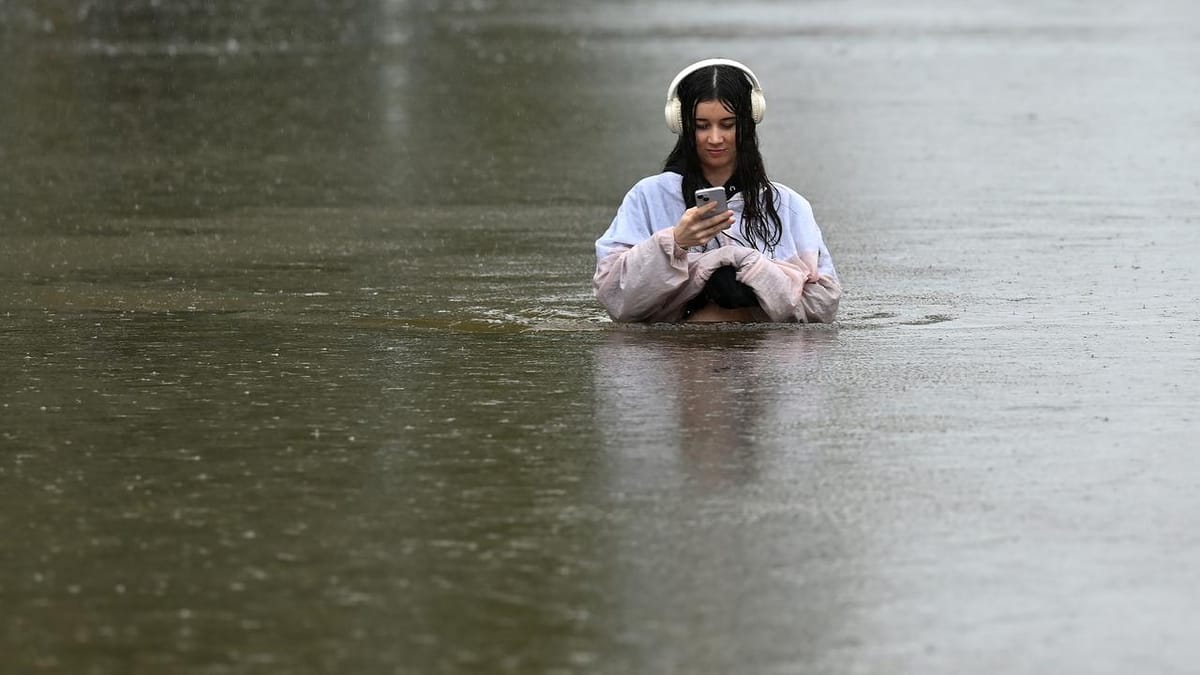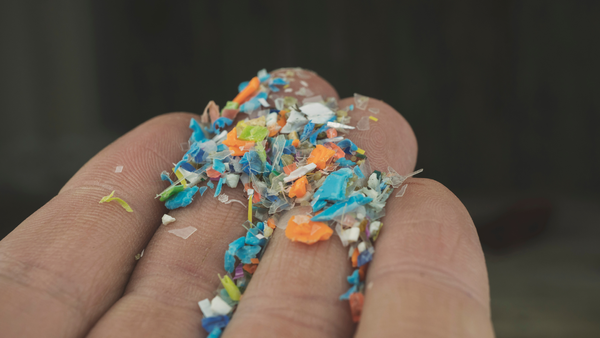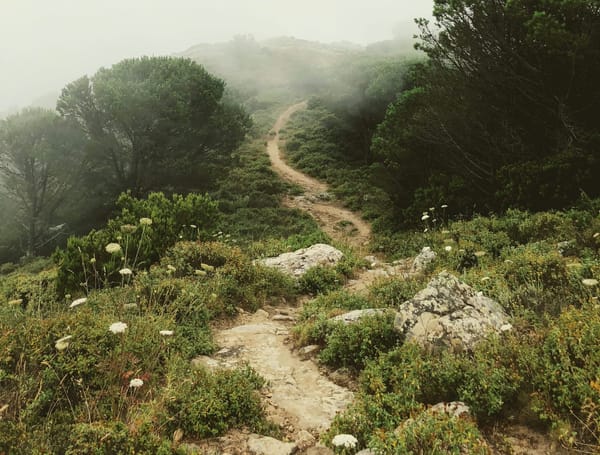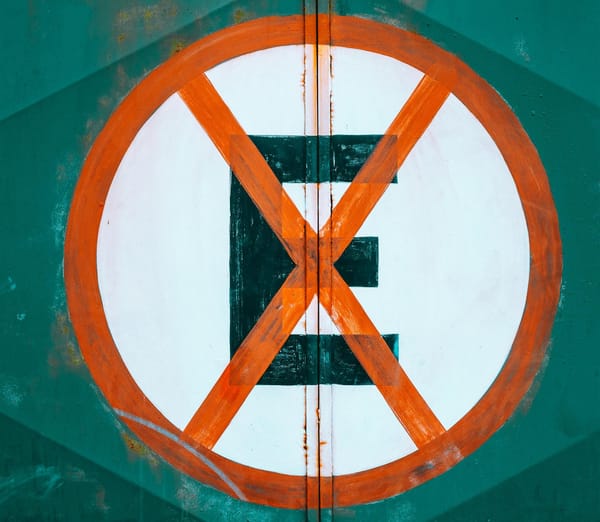The Climate Crisis Will Not Be Livestreamed
A striking image from the aftermath of Ex Tropical Cyclone Alfred becomes a Rorschach Test for our climate future

We're finally back with our regular programming after the interruption that was Ex-Tropical Cyclone Alfred. While we dodged a bullet here in the Northern Rivers, the disruption was still substantial.
The community dropped everything after we received a warning that the storm could cross as a Category 3 cyclone as early as the next day.
We knew what we had to do for flood prep, but cyclones aren't meant to come this far south, so adding cyclone prep onto the sandbagging and trench digging was a new one. Once the flood prep was done, we had to move all of the furniture and other potential projectiles from our decks and garden either into the house or the garage. Then we got the chainsaw out to take down any branches and, in some cases, whole trees that were a risk to our house and powerline.
We had a beautiful Tibouchina in full bloom out the front of our kitchen whose two main boughs went either side of our powerline that had to come down.

The butterflies were confused, and we were heartbroken, but we couldn't risk leaving it.
In the end, Alfred thankfully crossed north of us near Brisbane four days later as a much milder tropical storm. We lost a lot of trees, had some minor flooding and were without power for a few days.
We were lucky... this time.
Even the many Queensland communities that copped the brunt of the storm were lucky that the storm didn't cross on Wednesday or Thursday when it was a Category 2 or 3. As it was, the storm swells have decimated the iconic coastlines from the Gold Coast down, excavating six-metre walls out of the dunes.

Everyone who lives in this region (and the insurance companies) has become acutely aware that this scenario is much more likely in a warming climate.
Tropical cyclones aren't meant to come this far south—we're the subtropics. But this particular tropical cyclone was able to grow in strength down here thanks to being fed by the 27-degree water temperatures off the coast. It has already been confirmed that a “decade of inaction” on climate pollution and the hotter Coral Sea has cost Australians $1.2bn in the wake of Tropical Cyclone Alfred.
Sure, anomalous weather events happen all the time, but it's the frequency that's signalling that there is something is going seriously awry with our climate. After all, Cyclone Debbie caused once-in-a-hundred-year flooding here in Mullumbimby only eight years ago in 2017, then five years later, we had an even more catastrophic once-in-a-thousand-year flooding in 2022, only for the region to then experience another once-in-a-hundred-year flood a month later.
That math, as they say, ain't mathin'.
For every degree Celsius of warming, the atmosphere can hold approximately 7% more water vapour, a phenomenon known as the "temperature-water vapour feedback" that amplifies warming and increases the potential for extreme rainfall events. So, this is only going to get worse.
Oh, and in between these two events, we had the Black Summer fires in 2019. About 7% (5.5 million hectares) of NSW was burnt during the prolonged 2019–20 Black Summer fire season. The total area burnt was four times greater than the previous worst forest fires recorded in a fire season.
Here in the Northern Rivers, we had ancient rainforests on fire that had never burned before. The rainforest is typically too wet to burn, but the extended drought and heatwaves had dried it out to a crisp.
The facts are pretty grim. As the climate warms, extreme weather events will become more frequent.
As you can see below in graph format, the distribution of weather events shifts towards more extreme conditions becoming more frequent as the temperature increases.

Despite all the net zero strategies, activist efforts, and renewable energy projects, emissions aren't coming down. With the air deflating out of the ESG hype bubble and Trump in power, it looks like we've locked in a catastrophic 3 degrees of warming, save for some kind of geothermal deus ex machina miracle coming in at the last moment to save our species.
All of this was playing on my mind when the image at the top of this article started appearing in my feeds. Here it is again, so you don't have to scroll back to the top.

It's a striking image. I had already seen it featured across several news sites, including the BBC, News.com.au, and The Saturday Paper, but in social feeds, it had taken on a life of its own, including this post on LinkedIn that amassed over 400 comments. Without context, people were projecting their attitudes and anxieties about the climate crisis onto it like a Rorschach Test. I saw the full gamut, and it fascinated me.
Climate denial / Climate delay
I group these two together as they effectively have the same outcome. Here in Australia, we have our coalition Liberal and National parties on a unity ticket of climate denial. These attitudes range from outright denial that physics has it all wrong, that there is no greenhouse effect and digging up all that ancient sunshine and carbon and having it hang in the atmosphere doesn't warm the planet at one end of the spectrum. On the other, some admit that there is a link, but that Australia's contribution is so small that we don't make a difference (which is also furphy given Australia ranks as the world's third-largest fossil fuel exporter after Russia and the United States) and that the cost is too large to do anything about it.
Meanwhile, our Labor party, who are currently in power, make all the right noises about believing in climate change and have made some progress on some emissions abatement policies, but their constant approval of new coal mines and expansions of existing coal mines flies in the face of science and represents classic climate delay. The International Energy Agency (IEA) has made it clear: new or expanded coal mines are incompatible with limiting global warming to 1.5°C. Even for steelmaking, existing coal supplies are capable of meeting demand through to 2050.
To some, this image represents, whether through denial or delay, how politicians and corporate leaders are carrying on with business as usual, maintaining the status quo despite knowing the consequences. In that respect, it reminds me of Isaac Cordal's 'Politicians Discussing Global Warming' sculpture in Berlin.

Al Gore called his infamous film 'An Inconvenient Truth' for a reason. It's a problem that was difficult to solve back then, and it's become so much harder now. The best time to solve it was 30 years ago; the next best time is now. But it seems we have given up. To butcher an old adage, it seems that our leaders can sooner imagine the end of the world than an end to our convenience culture and its consequences.
An inconvenient truth indeed.
Climate Amnesia / Climate Paralysis
Climate Amnesia and Climate Paralysis are something we're all guilty of. And can be forgiven for doing so. Life in a metacrisis, augmented by a cost of living crisis, means there is never a shortage of stresses and other catastrophes that need our attention on any given day.
Covid stopped the momentum of the climate protest movement dead in its tracks. Post-Covid, people still believe in climate change and want governments, businesses, scientists, and engineers to act on it, but they themselves are ignoring it or forgetting entirely that we need to act if we want to see change.
Often, this amnesia is fed by a sense of powerlessness. Most people know the problem is real. They know it’s urgent. But they don’t know what to do. The problem feels too big, too distant, too far beyond their control. What can one person do against floods, fires, and collapsing ecosystems? So they do nothing. Not because they don’t care, but because they don’t feel connected enough to make a difference. And that’s the real danger—not denial, but despair.
So for some this image represented people ignoring our climate reality, looking away... even though they care. The storm is here, the water is rising, and yet, we keep scrolling.
Climate Resilience
This is what I projected onto the image. When I told the Phantm team on Slack that I would be offline until further notice, Elliot (our CEO) commented that I really was on the front lines of the climate crisis.
And that was because this wasn't the first time I'd made that call. Almost three years to the week, Elliot had kindly given me 2 weeks off to help with the recovery efforts after the 2022 floods that decimated our community. I'd never seen anything like it. Waves were coming down Main Arm Rd at the end of our street. A mate two blocks back had evacuated his family onto their roof. When I went out to rescue our chooks at the back of our yard, it was like wading through the shallows of the beach during a big surf the tow of the current was so strong.
People asked me if we were going to move away after I experienced that. There's no way. What I learned from the experience was that if there was ever a community to ride out the climate crisis with, it was this one.
We were cut off from everything for a week and a half. Even the military didn't get here until 8 days later, and the emergency services were hobbled by bureaucratic red tape. We had no access to power, money, services, or comms. But the community pulled together to make sure everyone was getting looked after. People doing the clean-up reported back on what was needed at each house to a central nerve centre that then dispatched electricians, carpenters, generators, and even mental health and medical assistance. Rescue teams were being sent up into the hills where there was a landscape collapse event, and some local legends were funding and organising helicopter drops. People were doing food drops, and every house I scraped mud out at always had someone dropping a packed lunch off around lunchtime.
As one German woman said as we were cleaning out our house, "Why does it take a natural disaster for us to be like this?". It was a glimpse of another way of being, of a communitarian spirit where everybody brings their unique talents for the betterment of the whole community.
It was a beautiful thing to witness, to be a small part of. So much care, kindness, compassion, cohesion, selflessness and even bravery.
But soon enough, as the roads opened up and the services came back on... so did everything else. The flood waters had receded, and the outside world came flooding back in.
We were connected to the global system again.
Our lives and our homes were still in disarray. But the deadlines hadn't moved. The work still needed to be done, kids needed to be cared for and sent off to school (running off generators), and the bills kept coming in and needed to be paid. So, with chaos all around, you do what you can to stay afloat and stay connected, jump on that Zoom call, get paid and get on with it. After all, it's just another day on the front lines of the climate crisis.
Connectivity
The other thing that leapt to mind when I saw this image was the importance of connectivity in (un)natural disasters.
Staying connected during a crisis isn’t just about convenience—it’s about survival. It’s hard to describe how essential connection is in a wildly unpredictable and erratic situation like a cyclone or catastrophic flood. Staying abreast of alerts, hazards, and evacuation orders and finding out who needs help where when we’ve been ordered to seek shelter becomes essential.
Community and neighbourhood Facebook groups and WhatsApp group chats come into their own at times like this. Decentralised and distributed knowledge networks cohering in mutual aid and info sharing. The disinfo and misinfo (that normally runs rife in these community groups) is quickly curated out by the crowd when the stakes are this high.
It’s the golden shadow of the tech that normally divides us. At times like these it really does deliver on their unrealised promise to break down barriers and pull us together to make things better.
But for that to happen, we need a robust mobile network that keeps us connected. I’m not expecting perfection. Drop outs are bound to happen. But the moment, we lose power at times like these, the mobile network collapses. As happened during Alfred. Fortunately, many local resilience groups were prepared, dropping two-way radios off to residents of remote rural communities.
Governments and essential service providers need to start building climate resilience into our infrastructure—not just as an afterthought, but as a priority. Yet, three years after the catastrophic 2022 floods left us cut off from the outside world for over a week, nothing seems to have changed.
The Full Story
Of course, as is often the case, the real story behind this picture is more mundane than all of this conjecture. Regardless of what thousands of others or I have projected on this image, in the end, it's of a girl wading into the flood waters to take a selfie—maybe for a lol, maybe for social clout, maybe just to remember what it was like. Preceding images taken by the photographer show her taking the selfie. The image that featured in all of this social discourse (and the newspapers) is of her checking the results a few moments later.


A picture may say a thousand words (as is the case with this post), but it doesn't always tell the full story.
The full story is that these events will become more extreme and more frequent, and climate denial, delay, and paralysis are what got us here. Communities on the front lines have no choice but to be resilient in the face of these (un)natural disasters and rely on community and our devices and connectivity to stay abreast of what is happening, plan on the fly, provide mutual aid and keep people updated.
Some people piled onto this girl for being irresponsible, claiming that submerged hazards or flows could have gotten her (and anyone trying to help her) into difficulty. But I think this is a version of climate resilience: to bear witness, wade into the situation, and say, 'I was here.' The water looks still. So what if she gets some likes and social clout while she's at it?
This full story behind the image also reminds me of a tweet about these constant 'unprecedented' climate disasters we keep hearing about that went viral during the LA fires:
“Climate change will manifest as a series of disasters viewed through phones with footage that gets closer and closer to where you live until you're the one filming it.”
The climate crisis will not be livestreamed. It will be lived, and witnessed with your own eyes and those of your children and grandchildren. Like a spectre, it's impossible to know what form it will take when it comes for you and your community. But it is coming.
And what blows me away is that we know what's causing it and what we have to do to stop it.
And yet...





